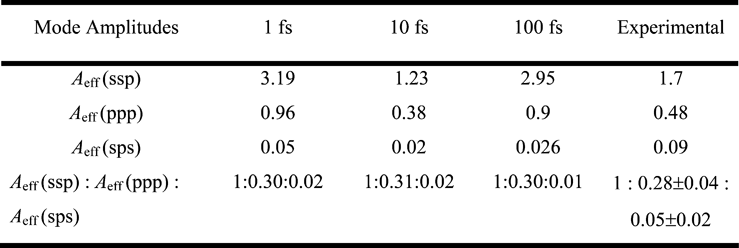 should read
should read  , where N = (T − t)/δt. A corrected Table 2 is given below and shows a definite improvement over the previous results, in terms of less dependence on snapshot size.
, where N = (T − t)/δt. A corrected Table 2 is given below and shows a definite improvement over the previous results, in terms of less dependence on snapshot size.| Phys. Chem. Chem. Phys., 2011, 13 | |
Additions and corrections Microscopic structure and dynamics of air/water interface by computer simulations—comparison with sum-frequency generation experiments |
Yanting Wang, Nathan O. Hodas, Yousung Jung and R. A. Marcus
Phys. Chem. Chem. Phys., 2011, 13, 5388–5393 (DOI: 10.1039/c0cp02745f). Amendment published 1st April 2011
The authors have provided the following information regarding corrections to some of the equations in their above article:
The corrected equations produce calculated ratios similar to those presented in Tables 2 and 3 of the article (see below), and the calculated magnitudes remain similar to the experimentally measured magnitudes of the Aeff’s in those tables. The method also provides a calculation, in agreement with experiment, of the average tilt angle of surface free OH bonds, number of free OH bonds, and the amplitudes and ratios of the Aeff’s, using the experimental linewidth Γq(14.5cm−1) and an additional parameter, the cutoff angle of the free OH bonds. A fuller presentation of the results using long time trajectories, ensemble averages, and additional water models, will be described elsewhere.
The corrections are as follows: in eqn (3) an iω2 is missing from the right hand side,1 and in eqn (4) and (5) the exp(iωqt), cos ωqt and the sin ωqt should read iωqexp(i(ω2 − ωq)t), cos (ω2 − ωq)t and sin (ω2 − ωq)t. The leading minus sign in eqn (5) should be removed. On page 5390, the units of beta should read m4 V−1 s−1. In Tables 2 and 3 the title should have s−1 instead of s and the expression containing  should read
should read  , where N = (T − t)/δt. A corrected Table 2 is given below and shows a definite improvement over the previous results, in terms of less dependence on snapshot size.
, where N = (T − t)/δt. A corrected Table 2 is given below and shows a definite improvement over the previous results, in terms of less dependence on snapshot size.
Table 2. Mode amplitudes and their ratios calculated from MD simulations and comparison with the experimental values. Aeff has units 10−9 m2 V−1 s−1.a

a Results of fitting the spectrum to a Lorentzian and correcting for experimental width.
1 Using the standard quantum mechanical expression for  containing a
containing a  and an α(0), an integration by parts led to eqn (3), with the cited iω2 term included. This ω2 in the pre-exponential factor was replaced by its value at the peak, ωq. A constant term from the integration by parts step is frequency-independent, forming part of the background, and is omitted. One then introduces a basis set for the oscillator q, only
and an α(0), an integration by parts led to eqn (3), with the cited iω2 term included. This ω2 in the pre-exponential factor was replaced by its value at the peak, ωq. A constant term from the integration by parts step is frequency-independent, forming part of the background, and is omitted. One then introduces a basis set for the oscillator q, only  and
and  being needed for the high frequency (3700 cm−1) OH oscillator, and one notes that the
being needed for the high frequency (3700 cm−1) OH oscillator, and one notes that the  depends on time as exp(−iωqt). With the corrections noted above, eqn (4) and (5) then follow, from which we calculate a spectral response. Because Wei and Shen (2001) extracted the Aeff’s by fitting the experimentally measured spectrum with a Lorentzian, we fit our calculated spectrum to a Lorentzian to permit a comparison. To obtain the final results for the Aeff’s it was assumed that a total “signal strength” (in the form of
depends on time as exp(−iωqt). With the corrections noted above, eqn (4) and (5) then follow, from which we calculate a spectral response. Because Wei and Shen (2001) extracted the Aeff’s by fitting the experimentally measured spectrum with a Lorentzian, we fit our calculated spectrum to a Lorentzian to permit a comparison. To obtain the final results for the Aeff’s it was assumed that a total “signal strength” (in the form of  ) was the same for the calculated and experimental models, giving
) was the same for the calculated and experimental models, giving  where δC and γ are obtained from the Lorentzian fit to the MD calculations,
where δC and γ are obtained from the Lorentzian fit to the MD calculations,  , and Γq(14.5 cm−1) is the experimental decay constant. The constant δC is the correlation function
, and Γq(14.5 cm−1) is the experimental decay constant. The constant δC is the correlation function  evaluated at t=0, where
evaluated at t=0, where  is the baseline of the plot. This δC is determined only by the equilibrium properties and is insensitive to the detailed dynamics, while the dynamics lie in Γq (and γ). Thus, when a single Lorentzian description and the above assumption are appropriate this method of analysis of the data separates the problem into an equilibrium part and a dynamical part.
is the baseline of the plot. This δC is determined only by the equilibrium properties and is insensitive to the detailed dynamics, while the dynamics lie in Γq (and γ). Thus, when a single Lorentzian description and the above assumption are appropriate this method of analysis of the data separates the problem into an equilibrium part and a dynamical part.
The Royal Society of Chemistry apologises for these errors and any consequent inconvenience to authors and readers.
Back to c0cp02745f